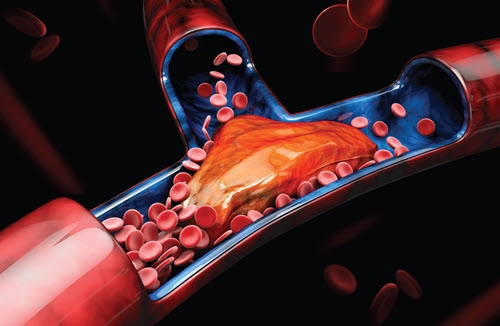General Surgery Coding Alert
Take This Quiz to Master ICD-10-CM Coding for Septic Embolism
Always target a primary diagnosis. When your vascular surgeon treats affected tissues related to a septic embolism, you need diagnosis coding know-how to support medical necessity for your surgeon’s work. Septic embolisms are arterial blockages that arise from a distant infection that travels through the arterial system and lodges in small vessels anywhere in the body, such as the lungs, the retina, or the digits. Study the following questions and answers to help you tackle ICD-10-CM coding for septic embolism conditions. Focus Septic Arterial Embolism Dx Question 1: Which ICD-10-CM code(s) should I report for septic arterial embolisms? Answer 1: You should report code I76 (Septic arterial embolism) for a septic arterial embolism. You’ll also need to indicate the location of the embolism with one of the specific four- or five-character codes in the 174.- family (Arterial embolism and thrombosis) such as I74.2 (Embolism and thrombosis of arteries of the upper extremities). Excludes 2: You’ll notice that I74.- codes have an Excludes 2 note for I76. “Recall that an Excludes 2 note doesn’t mean that you can’t report the codes together, it means that the specific condition is ‘not included here’,” says Melanie Witt, RN, CPC, MA, an independent coding expert based in Guadalupita, New Mexico. That means the I74.- code doesn’t include the I76 code, but the two conditions may occur together. If the op report indicates the anatomic site of a septic arterial embolism, do this: report both I76 to indicate that this is a septic arterial embolism, and the appropriate I74 code to indicate where the embolism is located. Note: ICD-10-CM instruction under both I76 states, “use additional code to identify the site of the embolism (I74.-).” Look for Septic Pulmonary Embolism Codes Question 2: What is a septic pulmonary embolism, and how should we code it? Answer 2: A septic pulmonary embolus originates from a localized infection such as an area of cellulitis or a central venous catheter infection. The embolic material travels through the venous system to the right side of the heart and moves into the pulmonary arterial system where it lodges in small vessels. For these cases, you should report either I26.01 (Septic pulmonary embolism with acute cor pulmonale) or I26.90 (Septic pulmonary embolism without acute cor pulmonale). Don’t miss: Cor pulmonale describes a condition involving right-heart failure. Underlying conditions can cause cor pulmonale, such as long-term high blood pressure. The acute form, however, which involves sudden right heart failure, is more likely due to an embolus obstructing the pulmonary artery. Delve Into Sequencing Rules Question 3: Should I list the septic arterial or pulmonary embolism code first in the diagnosis section, because it is the focus of the surgical treatment? Answer 3: Whether reporting septic arterial or pulmonary embolisms, you should never report these codes as the primary diagnosis. “Be sure to code the underlying infection first, such as infective endocarditis, a lung abscess, or an infection from an indwelling vascular catheter or graft,” says Robin Peterson, CPC, CPMA, manager of professional coding, Pinnacle Integrated Coding Solutions, LLC. Note: Septic embolism codes I26.01, I26.90 and I76 come with the ICD-10-CM instructional note to “code first the underlying infection.” Try Coding This Example Question 4: Following antibiotic treatment for a central venous catheter infection, the patient presents with fever and signs and symptoms of an acute abdomen. The surgeon proceeds with an exploratory laparotomy and finds multiple septic arterial emboli associated with small bowel ischemia and necrosis. The surgeon proceeds to remove the affected tissue and join the resected ends of the small bowel. How should we code this case? Answer 4: The primary diagnosis is K55.021 (Focal (segmental) acute infarction of small intestine). The inclusion terms for K55.0- list “mesenteric (artery) (vein) embolism.” You also need to indicate that the emboli are septic, which means you must “code first the underlying infection,” which is T80.219S (Unspecified infection due to central venous catheter, sequela). Next, you should list the septic arterial embolism code, I76. Because ICD-10-CM instruction for I76 states, “use additional code to identify the site of the embolism,” you should also report I74.8 (Embolism and thrombosis of other arteries). The surgeon begins with a diagnostic procedure: 49000 (Exploratory laparotomy, exploratory celiotomy with or without biopsy(s) (separate procedure)). However, the surgeon converts to a therapeutic procedure to remove the necrotic small intestine: 44120 (Enterectomy, resection of small intestine; single resection and anastomosis). Don’t: You should never report a diagnostic (separate) procedure with a more-extensive therapeutic procedure. That means the correct procedure code for this case is 44120.

Related Articles
General Surgery Coding Alert
- GI Procedures:
Sort 13 Inguinal Hernia Repair Codes to 1 Correct Choice: Here’s How
See how adding hydrocele removal changes things. If your heart sinks when you see an [...] - Clip and Save:
Chart Your Inguinal Hernia Repair Codes With This Handy Table
Use the following table to drill down through all the details from the op report [...] - Vascular Cases:
Take This Quiz to Master ICD-10-CM Coding for Septic Embolism
Always target a primary diagnosis. When your vascular surgeon treats affected tissues related to a [...] - HIPAA:
Take ‘Right of Access’ Seriously or Expect Enforcement Action
See whose record requests you must honor. With six out of seven HIPAA enforcement settlements [...] - You Be the Coder:
Revise Bilateral Ovarian Cancer Dx
Question: Our surgeon performed a bilateral oophorectomy and the pathology report showed epithelial ovarian cancer in [...] - Reader Questions:
Master Post-Bariatric Skin Removal Coding
Question: Our surgeon performed a procedure for a patient who had lost considerable weight following bariatric [...] - Reader Questions:
Stay Focused on H&P Documentation for Modifier 25
Question: Do the recent changes to E/M codes alter the way we use modifier 25? California [...] - Reader Questions:
Keep Compliant With HIPAA Risk Analysis
Question: Can we switch to gap analysis of how we implement HIPAA compliance instead of performing [...]




